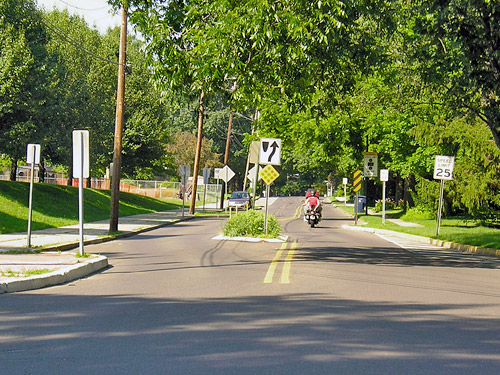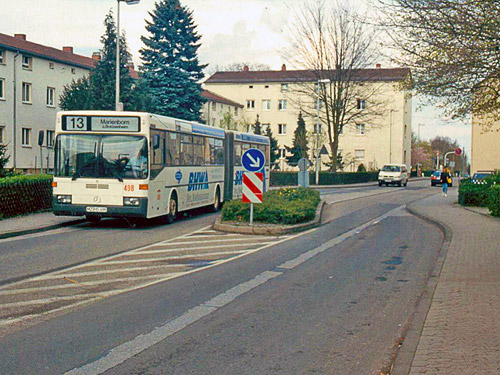A chicane is a series of alternating mid-block curb extensions or islands that narrow the roadway and require vehicles to follow a curving, S-shaped path, discouraging speeding. Chicanes can also create new areas for landscaping and public space in the roadway.
Process Overview
Chicanes are typically installed as part of a traffic calming project.
For more information on the traffic calming process, see Traffic Calming Overview
Traffic calming devices require approval by an SFMTA hearing officer. Additionally, if the project would result in a change to certain parking or traffic designations, it may require approval by the SFMTA Board.
See Permit Process
Official Codes & Documents
- Better Streets Plan (street design guidelines)
- SFMTA Traffic Calming Guidelines
Design Guidelines
Placement
Street Types: Neighborhood Residential; Alley; Shared Public Way
Sidewalk zones: Extension Zone; Roadway
Chicanes can be created on roads with various roadway configurations, as follows:
- On streets with space for parking on only one side, chicanes can be created by alternating parking from side to side. Chicanes can also be formed by alternating parallel parking and perpendicular parking. Curb extensions should be included at each end of on-street parking.
- Where a wide right-of-way allows, parking may be maintained on both sides of the street through the entire chicane, and the entire roadway can jog from side to side using curb extensions.
Chicanes in both conditions may include a median island at points of deflection to prevent speeding drivers from continuing straight down the center of the chicane, disregarding roadway markings.
Chicane with parking alternating from side to side.
Median islands and curb extensions (in chicanes as elsewhere) should include landscaping, seating, and stormwater facilities.
Because chicanes are intended to slow traffic, designs should consider transit and emergency vehicles:
- Chicanes should not be located on streets with Rapid or Local lines per Muni’s operating framework. Though generally discouraged, chicanes may be implemented on streets with Community lines only; in these cases, the chicane should be located at a bus stop so that the impact on transit service and passenger comfort is minimized.
- Chicanes must maintain required clearances for emergency vehicle access, 14 feet on a one-way street and 20 feet on a two-way street. Among traffic calming measures, emergency vehicle operators typically prefer chicanes to speed humps, but the Fire Department has not expressed a formal preference.
Chicanes should be designed to force vehicles to slow as they change course. Standard CA MUTCD formulas for calculating taper lengths for striping around a horizontal offset caused by obstacles in the roadway typically yield tapers too long to achieve the desired slowing of vehicles. Accordingly, chicanes should be designed using formulas for lower speeds than are actually desired on the street.
Where chicanes will added raised islands with curbs in the roadway, they should be reviewed by DPW Hydraulics to ensure that there is sufficient hydraulic capacity within the street cross-section. Stormwater features can help to offset reduced capacity from raised islands as part of chicanes.
Maintenance
Maintenance Responsibilities
With some exceptions, fronting property owners are responsible for the on-going maintenance and upkeep of sidewalk paving as well as all sidewalk elements directly fronting their property, such as trees, landscaping, and streetscape furnishings. Generally, the City is responsible to maintain roadway paving and other features in the roadway, such as medians.
See Traffic Calming Overview: Maintenance.
For a more detailed description of maintenance responsibilities, see Maintenance










 Copyright © 2015
Copyright © 2015